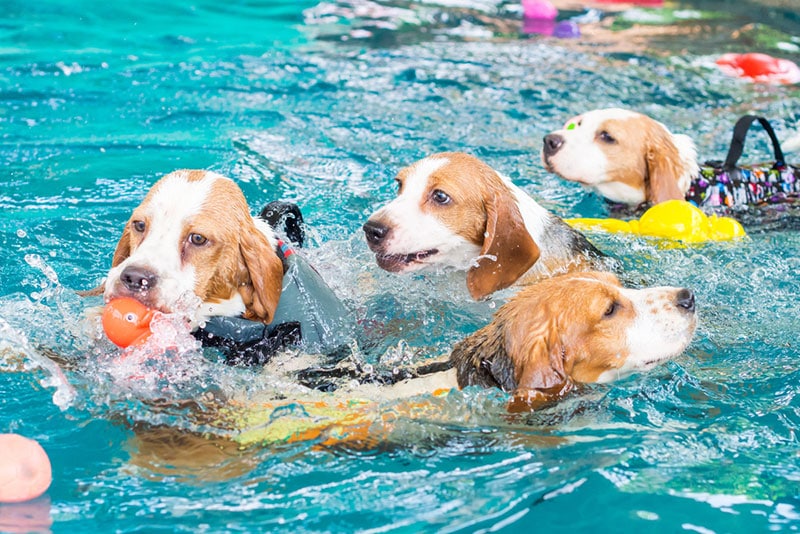How to Get Your Dog to Like Swimming: 7 Possible Ways

Updated on

Dogs and water sports are often hand-in-hand, and if you love swimming, it’s not surprising that you’d want your dog to come along too. Some dogs take to water like a duck, but others are more reluctant. If you want to teach your dog to like swimming, it’s important to help him have a good experience. Here are seven tips to help your dog swim happily and have as much fun as you do in the water.
The 7 Ways to Get Your Dog to Like Swimming
1. Start Young
It’s not always possible to get your dog in the water as a puppy, but the younger you start (within reason), the easier it will be. If you know you want to take your dog swimming in the summer, encourage bathtub play in the winter. Puppies usually take to water more easily than adult dogs, and it can be easier to soothe a scared puppy than help a 75-pound adult who’s determined to climb on you in the water.

2. Get a Life Jacket
It’s crucial to start your dog off with a lifejacket, especially if the water is likely to go deeper than your dog’s shoulder. Life jackets for dogs are generally made to support their weight, and even though most dogs can learn to swim without, they can keep your dog safe and calm as they swim. Let your dog try on the jacket for a few excursions before you get into the water, so he is used to it and doesn’t try to escape.
3. Pick Ponds Over Pools
This isn’t an ironclad rule, but many dogs are more comfortable swimming in lakes and ponds instead of pools, especially at first. The bright blue pool water can be unnatural and scary to a dog, and pools generally have limited entrances and exits, making it harder for your dog to get in and out because he has to find the steps again. Many pools are too deep for your dog to stand in the shallow end as well.

4. Start Slow
Pushing your dog into the deep end is generally not encouraged as that can scare your dog instead of helping him relax. Start by splashing around in the shallows or even running through a sprinkler with your dog. Look for warmer water or start on a hot day to make the water a more pleasant experience. Once your dog is comfortable in the shallows, encourage him into deeper water for short play sessions.
5. Bring a Friend
If your dog is generally a good playmate, another dog who already swims can be a good encouragement. Dogs can learn from watching other dogs, and a fearless friend can encourage your dog to play harder and not worry so much. If you can’t bring a second dog along, be ready to be your dog’s friend. Expect to have fun in the water and don’t take along humans that won’t get in at first.

6. Encourage Play
Water play can be a lot like land play, and many of the same tricks apply. If your dog likes playing fetch or with a frisbee, a floating toy can be a great temptation. Treats and positive reinforcement also help. While you are in the water with your dog, make sure that you’re paying lots of attention to him so that he learns that water time is play time and not something scary.
7. Support the Belly
Once your dog is getting more comfortable with splashing around, you’ll want to encourage swimming. Many dogs tend to sink into a vertical position when they first start swimming until they learn how to kick with their back legs to stay upright. In the meantime, putting a hand under your dog’s belly can be reassuring and encourage proper swimming. Over time, your dog will learn how to keep himself floating comfortably without your help.

Conclusion
Overall, swimming is something that dogs of all breeds and ages enjoy, but it might not come naturally. Getting your dog comfortable in the water is the first step, and once your dog begins having fun, you’ll see him learn to swim with incredible speed. Before long, your dog will be moving just as comfortably in the water as out of it!
- See Also: How to Teach a Dog to Swim: 5 Easy Steps
Featured Image Credit: 825545, Pixabay











